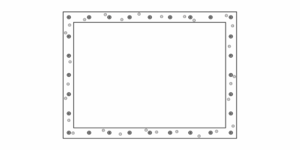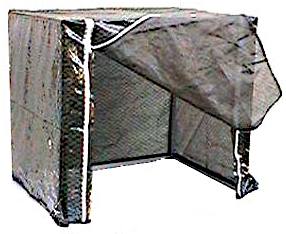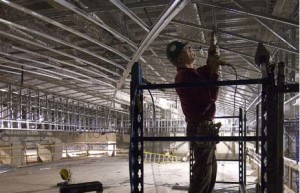A Faraday Cage, in case you haven’t heard of it, is a cage built from a metallic mesh that will prevent any EM fields from entering or escaping the space within. That’s nice to have in case someone fires off a nuke somewhere within 100 miles, or if some insidious nation actually comes up with an effective EMP weapon.
Wikipedia says it like this:
“A Faraday cage or Faraday shield is an enclosure formed by conducting material or by a mesh of such material. Such an enclosure blocks out external static electric fields. Faraday cages are named after the English scientist Michael Faraday, who invented them in 1836.[1]
A Faraday cage’s operation depends on the fact that an external static electrical field will cause the electrical charges within the cage’s conducting material to redistribute themselves so as to cancel the field’s effects in the cage’s interior. This phenomenon is used, for example, to protect electronic equipment from lightning strikes and other electrostatic discharges.”
So why would you want one, or need one, unless you’re a computer technician testing highly sensitive equipment for, let’s say space travel?

Well, there are a number of reasons why a Faraday Cage is useful to many people – including the likes of you, dear reader. Faraday cages not only block cell phone signals, radio waves and static, they also (if constructed correctly) block out potentially harmful waves that are currently travelling in your windows and walls, and through you and your precious cells. In these days of 3G networks, with 4G coming up, the debate is running high about whether or not electro magnetic (EM) radiation is damaging. A Faraday Cage can actually eliminate such radiation in your home.
In addition to the possible health benefits, a Faraday Cage will also be a very good idea if you’re planning a safe room in your new house, or adding one to that planned renovation you’re starting. Blocking EM transmissions might seem like a bad idea if you’re trying to call for help, but a land line (or more) is much harder to disturb or tap than a cell phone – remember that if you’re in

the cage, EM signals from the outside can’t come in and disturb equipment that you have set up in there, in order to communicate or monitor the outside world. Hard lines are your best bet, and if you have several, then whoever is outside trying to get at you will likely miss at least one of them, while it takes only a single signal jammer to knock out all your wireless stuff.
How to build one.
There are actual companies that can do this for you – no surprise there, since there are companies that do just about anything these days, but this is one that you can actually do yourself, or get that contractor you already hired to do for you. Here are some easy (and refreshingly short) instructions from an actual physicist:

“[Use] enameled magnet wire spaced 3″ apart horizontally. Across these are random crisscross wires creating an x pattern. Next each intersection the wire is soldered, then across the middle set in a strip of 12 ounce copper sheet 12” wide. Lay this around the center of each plane (i.e. wall and ceiling.)
Solder connect the wires at random points to the sheet. Use wide strips of the copper to connect all the copper sheets together bind and solder. Then attach a heavy copper cable to a ground rod outside the building and bind and solder the cable to the copper sheet. Then sheet rock over it to hide it from damage and view. This cage is designed to absorb a wider spectrum of energies than a conventional Faraday cage.”
Essentially, that’s all there is to it. Remember that for electrical work, you need a licensed electrician, and the rest of it you had better have at least the help of an experienced contractor to do.
Other than that, good luck with your new Faraday Cage, and EM-free living.

Does a Faraday cage have to have a ceiling to work: at all or a bit? Andy research to point to?
Yes, both floor and ceiling.
The idea is to block out EM signals / radiowaves etc. by diverting the charge that is carried through the air into ground. Simply put.
Go ahead and check out the links in the article – I think that’s about all you need both to understand the Faraday cage and to build one yourself.
Thanks for commenting!
Also good for EMPs? you would probably need a floor and have it all sealed up though.
is there any thing like xray cage .. to protect it frm
xrays .. u kno wht i mean
If a faraday cage contains a computer side of it, and that computer has cables which come out thru a small opening and connects to a computer scree, outlet, etc.. will that faraday cage be effective against EMI?
Ed, check out the last page of this document http://www.syfer.com/category_docs/filtgeninfo.pdf
They say it best:
“To prevent interference entering or leaving a piece of equipment,
feedthrough EMI filters can be mounted in the wall of a shielded
case. Any incoming or outgoing cables would then pass through
the filters. Power or wanted signals pass through the filters
unaffected, whilst higher frequency interference is removed. While
the screened case protects against radiated interference, the
feedthrough filters protect against conducted interference. The
integrity of the equipment is thus assured.”
Thanks for the great info! I have a question reagarding faraday cages: I see that there is several suppliers out there that supplies cotton-like -fabric with the ability to block out EM-radiation. If I were to make a dress out of this fabric, would it protect anything at all against radiation (because I obviously have to make holes to head and hands).
Thanks,
Td
Hi TD. No, a faraday cage won’t protect you from radiation, at least not to any mentionable extent. There’s a bit more to building faraday cages than one might think – we’ve only covered the basics. All faraday cages won’t block all frequencies, for example.
In order to block radioactive radiation, for example, you need a barrier, not a cage. I.e. you need to make that dress out of lead… which would make for a heavy dress. Or suit. Or sweater-vest. Or whatever.
Would a faraday cage stop a microwave attack? thanks
No, not really. It kind of depends on what kind of microwave energy we’re talking about – build a miniature cage and put it in your kitchen MW and see for yourself. Stand back, though…
How about protecting an electronic lock on and in a steel safe. The lockworks are behind the door but the access is on the front including the 9 volt battery access. Will the safe protect anything inside??? Can I make a shield for the front finger pad including the battery?
Thank you
Ward
You need to think of the fact that a Faraday Cage needs to be separate from other materials that can conduct current. What you put inside that cage is your own choosing, of course. Build a cage, put your safe inside it. Simple as that.
SS
Faraday Cages, microwaves and the afterlife. Your 8-12-11 11:09p reply re MW energy made my day. Visions of a turkey rocketing out of that MW flashed before my eyes. Loved your advice.
Hehe! Thanks. I wonder if he ever tried it…
Hi,
Could a cage be used to protect us from the smart meter.I live in a unit and opposite my bedroom is the electricity box with 10 meters in it.I am really worried about the radiation when the smart meters will be installed.Could I suggest to build a faraday
cage around it?
Hey Nel.
That’s a little bit crazy. A meter is a meter – it shows you some info about something else that the meter is metering… The only thing it does differently from old meters is talk to the electrical company (or gas or water or whatever kind of smart-meter you’ve got) and they’re not going to talk to it a lot, either.
Look, don’t worry about the smart meter. There are so many other, more important things to worry about.
SS, Sorry, but smart meters are actually making a lot of people sick. They pulse microwave radiation through your home and body 24/7. They are very dangerous, and can start electro-hypersensitivity or make it much worse. Please see………..
http://www.electricalpollution.com/smartmeters.html
and
http://stopsmartmeters.org/why-stop-smart-meters/
and
http://www.emfwise.com/smartmeters.php
Hi Jill.
Thanks for the links – we’ll have to look into those a bit more, and we see the point now.
There seem to be a lot of concern that these devices are transmitting “microwaves” – that seems strange.
In any case, a faraday cage would certainly work, but it’d be a plus to know what frequencies you want to block. Also, that would prevent the power/gas company from making contact with the device, which might prompt a visit.
I am also doing research into a Faraday to block my smart meter signals. EM aside, I’m more concerned with the privacy aspect of these devices. Power companies can check my usage every month and bill me, but they have no need to know about every second of every day and the devices inside based on their patterns.
How could one go about finding the wavelength to block. I know its a Radio mesh in the 9 gig range, but have no idea where to research more on the subject.
Is there any way to protect yourself against an LRAD attack?
Can an old refrigerator be used as a Faraday cage?
That would probably function more as a barrier than a cage, but if the thing is really old then it’s probably lead lined and will be an excellent such. Won’t be a Farsday cage, though.
I work for a shop that has an exposed, functioning I-T-E Switchboard (provides power to the 5 floors of the building) directly behind the cash wrap we sit at daily. The piece is an aesthetic complement to our shop, however it is consistently putting off somewhere around 5-10 milligauss while we sit at the register.
We want to build a faraday cage, around either the switchboards or where we sit at the register in order to protect against any potential EMF damage.
Does anyone have any suggestions or resources that may be good to look at when considering this project? Will it need to be a completely closed volume, or could we build more of a screen wall that separates us from the switchboards?
Thanks for any input.
Cheers!
A partial Faraday cage probably won’t do much of anything. You’ll probably need a barrier of some sort, which will screw up the pretty-part of the equation, but it might still be a good idea if you’re really worried about the EMF.
Question about grounding of the cage. In Farafay’s experiments his cage was not grounded, and thusly the “field” was generated around the vessel, leaving the inside of the vessel safe (i.e., a zero charge). It would seem that this is also true with the airplane occupants being protected inside when struck by an energy source outside, and also that the occupants a car are safe within a car during an electrical storm (excluding the exploding gas issue… of course)… again the car is on rubber tires an not grounded. So, it seems that a grounded metal vessle would be passing the charge down the path of least resistance, as it would in a lightning rod, rather than setting up the Farady Field effect. Do you have any comments, or sources that could help in seeing this more clearly?
There is a house my daughter is consider buying where the refrigerator is right on the other side of the outside wall with the Smart Meter. Will the field (EMF or electrical) of the powerful fridge motor/pump etc amplify the bad effects of the microwaves from the Smart Meter or cancel it out or what?
Most appliances etc. are built specifically to not interfere with, or emit EM. So the fridge will probably do nothing to the SmartMeter, except protect what’s inside it from some of the EM…
Here is the instructable for a Faraday cage that is easy to make (modify) and will look good in the house.. It also doubles as a file cabinet
http://www.instructables.com/id/Stylish-Two-Drawer-Faraday-Cage/?ALLSTEPS
Hi Lux. Thanks for the comment and the link.
However, that’s hardly a very viable Faraday cage – it’s basically a grounded file cabinet. Now, if there were even basic instructions on how to isolate the interior, I’d be more onboard with it…
I like to build a room to protect against EMF such as cellular, smart meters, etc..
What type of screen would work without spending the money for copper screening?
Would a standard screen used on windows and doors work?
aluminum screen will work but fiberglass won’t but i’m doing the same
Hi
My next door neighbours attached hose have just installed 10 solar photovoltaic solar panels complete with an inverter and I am being wakened up 3 times a night and each time I can hear pulsating noises is their any way to stop this my wife can hear nothing and is not disturbed at all however when I am sleeping elsewhere all these problems disappear I even can hear the pulsating noise with ear plugs in place.
Kind regards
Alex
Chances are the battery charger function of the system is charging the batteries from grid during low sunlight. I do not know this to be true but I would think along these lines;
If there is a piece of equipment in his system which is attached to or is sitting on the floor, it should be placed on a pad. The pad may have to be metallic (conductive) if the unit must
be grounded – or a grounding cable can ground it.
Low freq vibrations/sounds travel far and easy through earth, solids, etc. I would not be surprised that you hear this sound – even with ear plugs in. Ask him to allow you to call him when you hear it and have him view the set up to see which item is powered up or is making sound or is vibrating. It would be even better if you were there with him to locate the unit because you know the sound. Tell him what you need to in order to get him to agree.
If it happens on a scheduled time frame, maybe you could predict when it will start and be there. Pad it. Keep it from vibrating the floor, etc.
Stainless steel wire mesh is used as material for building faraday cage. such as 80 mesh,100 mesh.
Building a Faraday cage in the back yard. I want to cover the walls in sheet rock and paint. Will this affect it’s ability to function properly? I plan to use 16g copper mesh around the whole 12’X12′ grounded. I am also looking into where to buy operable windows, if they even make such a thing.
Thanks,
Ryan